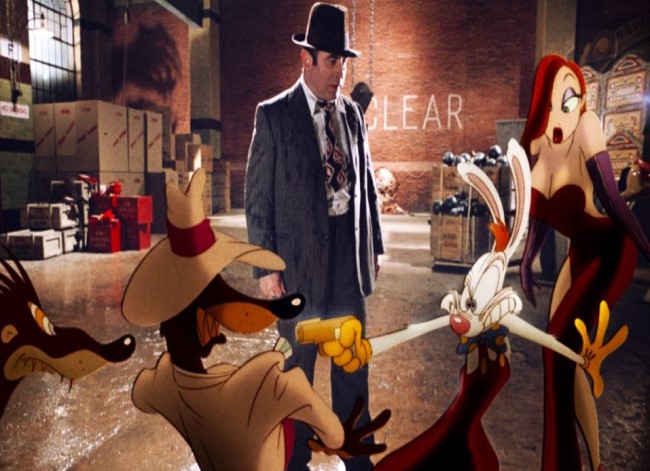Who Framed Roger Rabbit Noir: A Genius Blend of Animation and Film Noir

Who Framed Roger Rabbit Noir is a phrase that perfectly captures the unique cinematic blend that defines this iconic film. Released in 1988, Who Framed Roger Rabbit isn’t a traditional film noir, yet it draws heavily from the genre’s aesthetic and narrative structure. The film combines slapstick cartoon comedy with the dark, shadowy world of noir, resulting in a revolutionary hybrid that broke boundaries in storytelling, animation, and genre. This article explores how the movie embodies noir elements, where it diverges, and why it remains a timeless classic.
What Is Who Framed Roger Rabbit?
The Film in a Nutshell
Who Framed Roger Rabbit is a groundbreaking film directed by Robert Zemeckis that mixes live-action with animated characters. The story is set in 1947 Los Angeles and follows private detective Eddie Valiant as he investigates the framing of cartoon star Roger Rabbit for the murder of Marvin Acme. The film masterfully merges the cartoon chaos of “ToonTown” with the gritty atmosphere of classic detective fiction.
Film Noir Basics
What Defines Film Noir?
Film noir is a cinematic genre known for its cynical tone, shadowy visuals, morally ambiguous characters, and themes of crime, betrayal, and fatalism. Originating in the 1940s and 1950s, noir films often featured private detectives, corrupt officials, and seductive femmes fatales.
Is Who Framed Roger Rabbit Film Noir?
This brings us to the question: Is Who Framed Roger Rabbit film noir? The answer is both yes and no. While it borrows heavily from the noir playbook, it isn’t a pure example. Instead, it uses noir elements to enhance a story that is also comedic, fantastical, and emotionally rich.
Noir Elements in Who Framed Roger Rabbit
A Classic Noir Setting
The story unfolds in post-war Los Angeles—a staple location in noir history. Films like Double Indemnity and Chinatown made the city synonymous with moral decay and urban mystery. The foggy streets, jazz music, and vintage cars evoke the unmistakable noir atmosphere.
Eddie Valiant – The Flawed Hero
Eddie Valiant, played by Bob Hoskins, is a textbook noir protagonist. He’s a disillusioned, alcoholic private investigator mourning the loss of his brother. His cynical outlook and gruff demeanor align perfectly with the tormented detectives seen in classics like The Maltese Falcon.
Jessica Rabbit – Femme Fatale Reimagined
Jessica Rabbit is perhaps one of the most iconic characters in the film. She looks, sounds, and acts like a traditional femme fatale. However, her motivations turn out to be far more genuine than those of traditional noir women, making her a subversive twist on the trope.
Where the Film Deviates
Humor and Cartoon Chaos
What sets Who Framed Roger Rabbit apart from traditional noir is its injection of cartoon humor. The exaggerated antics of the animated characters—Roger’s wild expressions, slapstick gags, and chaotic physics—break the somber tone typical of noir. This comedic layer makes the film accessible to a wider audience.
Clear Moral Lines
Unlike many noir films where everyone is morally compromised, Roger Rabbit maintains a clearer line between good and evil. Eddie undergoes a redemptive arc, Roger is innocent, and the true villains are revealed and punished.
Genre Fusion Done Right
A Tribute, Not a Copy
Rather than mimicking noir, Who Framed Roger Rabbit pays homage to it. It borrows the genre’s visual style—such as dramatic lighting, long shadows, and claustrophobic cityscapes—while integrating them into a world where cartoons and humans coexist.
Perfect Balance
The film balances noir’s grit with cartoon absurdity. This genre-blending is not just a stylistic gimmick—it enhances the story. The animation allows for more expressive storytelling, while noir lends gravity and depth.
Related Keywords in Focus
“Is Who Framed Roger Rabbit Film Noir?”
This question frequently arises in film discussion circles. The best way to answer is that it is a neo-noir or noir-inspired film. It doesn’t follow every rule of classic noir, but its aesthetic and character archetypes clearly pay tribute.
“Who Framed Roger Rabbit Film Noir”
The term “Who Framed Roger Rabbit film noir” often surfaces in academic discussions and film critiques. Scholars and movie buffs agree that while it’s not noir in the strictest sense, it uses noir tropes so effectively that it deserves a place in the conversation.
The Legacy of Who Framed Roger Rabbit Noir
Industry Impact
The film was revolutionary in many ways. It proved that animated and live-action characters could coexist in a believable world. Its noir elements gave it narrative credibility, while its technical innovations influenced a generation of filmmakers and animators.
Cultural Significance
Today, Who Framed Roger Rabbit stands as a cultural landmark. It’s studied in film schools, analyzed in essays, and celebrated for its unique blend of genre, tone, and technique. It’s one of the rare films that is both a love letter to the past and a trailblazer for the future.
Final Thoughts
Who Framed Roger Rabbit Noir isn’t just a clever combination of words—it reflects the spirit of a film that dared to mix the dark allure of noir with the light-hearted chaos of animation. The result is a cinematic experience that is as emotionally compelling as it is visually imaginative.
So, is Who Framed Roger Rabbit film noir? Not quite. But it’s noir enough to belong in the same breath. It’s a hybrid, a genre-defying masterpiece that both honors and redefines the conventions of noir. In doing so, it created something truly unique—a modern classic that continues to captivate audiences of all ages.



